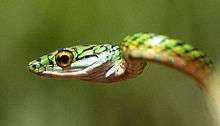Leptophis ahaetulla
| Leptophis ahaetulla | |
|---|---|
 | |
| Scientific classification | |
| Kingdom: | Animalia |
| Phylum: | Chordata |
| Class: | Reptilia |
| Order: | Squamata |
| Suborder: | Serpentes |
| Family: | Colubridae |
| Genus: | Leptophis |
| Species: | L. ahaetulla |
| Binomial name | |
| Leptophis ahaetulla (Linnaeus, 1758) | |
| Synonyms | |
| |
Leptophis ahaetulla, commonly known as the lora or parrot snake, is a species of medium-sized slender snake of the family Colubridae.[3] It is endemic to Central America and northern South America.[4]
Distribution
- Central America: Belize, Costa Rica, El Salvador, Guatemala, Honduras, southern Mexico, Nicaragua, Panama.
- South America: Argentina, Bolivia, Brazil, Colombia, Ecuador, French Guiana, Paraguay, Peru, Trinidad and Tobago, Uruguay, Venezuela.[1]
Description
Adults may attain a total length of 172 cm (68 in), which includes a tail 59 cm (23 in) long.[2]
Dorsally, Leptophis ahaetulla is bright green, golden, or bronzy. The keels of the dorsal scales are black or dark brown. The head shields and the dorsal scales may be edged with black. On each side of the head is a black streak which passes through the eye. The upper lip and the belly are white or yellow. The species was thought to be non-venomous,[2] but it is mildly venomous with localized pain, swelling and a feeling "pins and needles" being the symptoms of envenomation. Symptoms disappear after a few hours.
The head is elongated and distinct from the neck. The eye is large with a round pupil. The body is slender, and the tail is long.[2]
The dorsal scales are arranged in 15 rows at mid-body and are strongly keeled except in the first row on each side (the row adjacent to the ventrals), where they are smooth. They are also smooth on the neck and tail.[2]
Ventrals 151-167 are strongly angulate at the sides, the anal plate is divided, and subcaudals 140-173 are divided.[2]
The loreal scale is absent, and the prefrontals extend through the loreal region to contact the upper labials. There are usually 2 postoculars, and the temporals are 1 + 2. There are 8-9 upper labials, of which the 4th & 5th (or 5th & 6th) enter the eye. The anterior chin shields are shorter than the posterior chin shields.[2]
Subspecies
Leptophis ahaetulla has currently ten recognized subspecies, including the nominotypical subspecies:[1]
- Leptophis ahaetulla ahaetulla (Linnaeus, 1758)
- Leptophis ahaetulla bocourti Boulenger, 1898
- Leptophis ahaetulla bolivianus Oliver, 1942
- Leptophis ahaetulla chocoensis Oliver, 1942
- Leptophis ahaetulla liocercus (Wied, 1824)
- Leptophis ahaetulla marginatus (Cope, 1862)
- Leptophis ahaetulla nigromarginatus (Günther, 1866) - black-skinned parrot snake
- Leptophis ahaetulla occidentalis (Günther, 1859)
- Leptophis ahaetulla ortonii Cope, 1876
- Leptophis ahaetulla praestans (Cope, 1868)
Leptophis coeruleodorsus Oliver, 1942 was formerly recognized as Leptophis ahaetulla coeruleodorsus.[1]
Diet
References
- 1 2 3 4 Leptophis ahaetulla at the Reptarium.cz Reptile Database. Accessed 31 December 2017.
- 1 2 3 4 5 6 7 Boulenger, G.A. 1894. Catalogue of the Snakes in the British Museum (Natural History). Volume II., Containing the Conclusion of the Colubridæ Aglyphæ. Trustees of the British Museum (Natural History). (Taylor and Francis, Printers.) London. xi + 382 pp. + Plates I.- XX. (Leptophis, pp. 105-107; and Leptophis liocercus, pp. 113-114.)
- ↑ Lawson, R.; Slowinski, J. B.; Crother, B. I.; Burbrink, F. T. (2005). "Phylogeny of the Colubroidea (Serpentes): New evidence from mitochondrial and nuclear genes" (PDF). Molecular Phylogenetics and Evolution. 37 (2): 581–601. doi:10.1016/j.ympev.2005.07.016. PMID 16172004. Archived from the original (PDF) on 2011-07-27.
- ↑ Boos HEA (2001). The snakes of Trinidad and Tobago. Texas A&M University Press, College Station, TX. ISBN 1-58544-116-3.
Further reading
- Freiberg, M. 1982. Snakes of South America. T.F.H. Publications. Hong Kong. 189 pp. ISBN 0-87666-912-7. (Leptophis ahaetulla, pp. 80, 101, 133 + photograph on p. 54.)
- Linnaeus, C. 1758. Systema naturæ per regna tria naturæ, secundum classes, ordines, genera, species, cum characteribus, diferentiis, synonymis, locis. Tomus I. Editio Decima, Reformata. L. Salvius. Stockholm. 824 pp. ("Coluber Ahætulla", p. 225.)